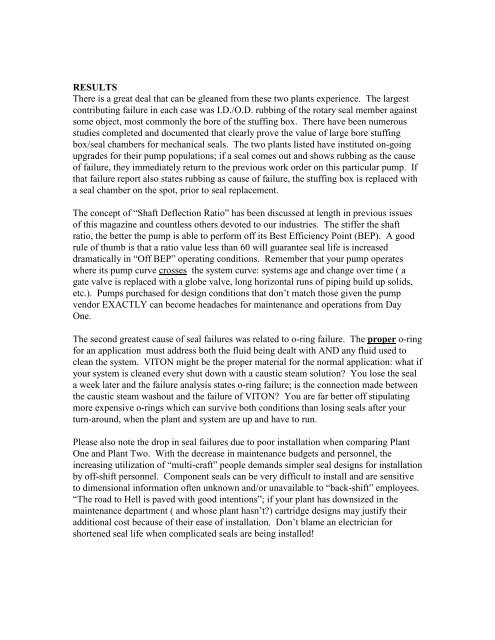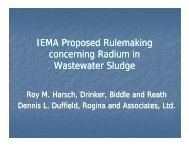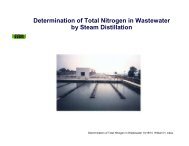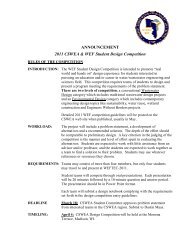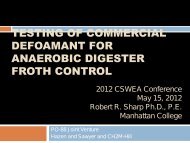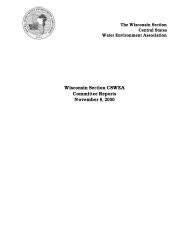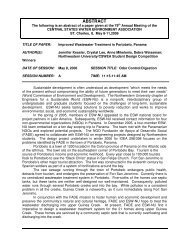Seal failure analysis results
Seal failure analysis results
Seal failure analysis results
You also want an ePaper? Increase the reach of your titles
YUMPU automatically turns print PDFs into web optimized ePapers that Google loves.
RESULTS<br />
There is a great deal that can be gleaned from these two plants experience. The largest<br />
contributing <strong>failure</strong> in each case was I.D./O.D. rubbing of the rotary seal member against<br />
some object, most commonly the bore of the stuffing box. There have been numerous<br />
studies completed and documented that clearly prove the value of large bore stuffing<br />
box/seal chambers for mechanical seals. The two plants listed have instituted on-going<br />
upgrades for their pump populations; if a seal comes out and shows rubbing as the cause<br />
of <strong>failure</strong>, they immediately return to the previous work order on this particular pump. If<br />
that <strong>failure</strong> report also states rubbing as cause of <strong>failure</strong>, the stuffing box is replaced with<br />
a seal chamber on the spot, prior to seal replacement.<br />
The concept of “Shaft Deflection Ratio” has been discussed at length in previous issues<br />
of this magazine and countless others devoted to our industries. The stiffer the shaft<br />
ratio, the better the pump is able to perform off its Best Efficiency Point (BEP). A good<br />
rule of thumb is that a ratio value less than 60 will guarantee seal life is increased<br />
dramatically in “Off BEP” operating conditions. Remember that your pump operates<br />
where its pump curve crosses the system curve: systems age and change over time ( a<br />
gate valve is replaced with a globe valve, long horizontal runs of piping build up solids,<br />
etc.). Pumps purchased for design conditions that don’t match those given the pump<br />
vendor EXACTLY can become headaches for maintenance and operations from Day<br />
One.<br />
The second greatest cause of seal <strong>failure</strong>s was related to o-ring <strong>failure</strong>. The proper o-ring<br />
for an application must address both the fluid being dealt with AND any fluid used to<br />
clean the system. VITON might be the proper material for the normal application: what if<br />
your system is cleaned every shut down with a caustic steam solution? You lose the seal<br />
a week later and the <strong>failure</strong> <strong>analysis</strong> states o-ring <strong>failure</strong>; is the connection made between<br />
the caustic steam washout and the <strong>failure</strong> of VITON? You are far better off stipulating<br />
more expensive o-rings which can survive both conditions than losing seals after your<br />
turn-around, when the plant and system are up and have to run.<br />
Please also note the drop in seal <strong>failure</strong>s due to poor installation when comparing Plant<br />
One and Plant Two. With the decrease in maintenance budgets and personnel, the<br />
increasing utilization of “multi-craft” people demands simpler seal designs for installation<br />
by off-shift personnel. Component seals can be very difficult to install and are sensitive<br />
to dimensional information often unknown and/or unavailable to “back-shift” employees.<br />
“The road to Hell is paved with good intentions”; if your plant has downsized in the<br />
maintenance department ( and whose plant hasn’t?) cartridge designs may justify their<br />
additional cost because of their ease of installation. Don’t blame an electrician for<br />
shortened seal life when complicated seals are being installed!


